Table of Contents
- Introduction
- Editor’s Choice
- Canned Seafood Market Overview
- Global Fisheries and Aquaculture Production
- Global Fish and Seafood Consumption Statistics
- Nutrients Found in Canned Seafood
- Types of Canned Seafood Products Consumed
- Reasons to Consumer Canned Seafood
- Consumer Preferences and Trends for Canned Seafood
- Regulations for Canned Seafood
Introduction
According to Canned Seafood Statistics, Canned Seafood offers a convenient and nutritious solution for consumers seeking quick and versatile meal options.
It includes varieties like tuna, salmon, sardines, anchovies, and shellfish, providing a rich source of protein, omega-3 fatty acids, and essential vitamins and minerals.
With a long shelf life of up to several years and minimal preparation required. Canned seafood is ideal for busy lifestyles.
Many brands prioritize sustainability and quality, offering eco-friendly packaging and adhering to rigorous standards throughout the canning process.
While consumers should be mindful of sodium content, innovations such as easy-open lids and single-serve pouches cater to modern preferences for convenience and sustainability, making canned seafood a popular choice for health-conscious individuals on the go.
Editor’s Choice
- The global canned seafood market revenue is projected to reach USD 51.1 billion in 2033.
- In the global canned seafood market, the distribution channels are predominantly divided between retail and food services. Retail channels hold a significant majority share, accounting for 58.30% of the market.
- The global canned seafood market is characterized by the presence of several key players, each holding varying market shares. StarKist Co. leads the market with a 14% share.
- The Asia-Pacific (APAC) region dominates with a substantial 46.5% share, reflecting the high demand and consumption patterns in countries such as China, Japan, and Southeast Asia.
- China consumes 57,475 tonnes of fish and seafood annually, reflecting its high demand and population size.
- In assessing the relative importance of various attributes of canned tuna, consumer preferences reveal a balanced prioritization among several factors. Packaging form emerges as the most significant attribute, with 25.49% of respondents indicating its importance.
- A typical serving of canned sardines provides about 15 grams of protein, 229 milligrams of calcium, and significant amounts of vitamins such as B12, D, and E.
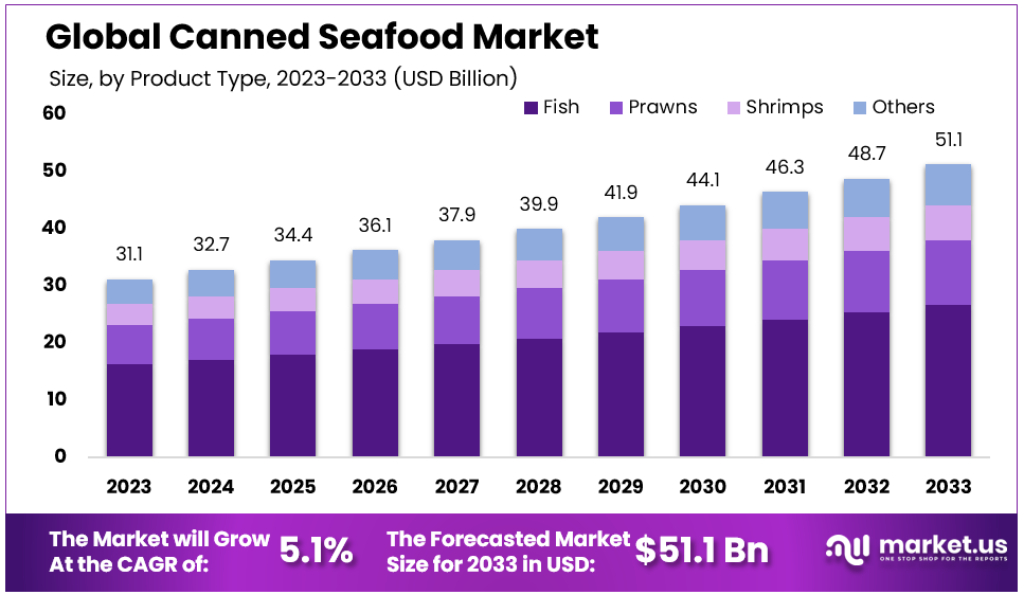
Canned Seafood Market Overview
Global Canned Seafood Market Size
- The global canned seafood market has demonstrated consistent growth over the years at a CAGR of 5.1%, with revenue figures indicating a steady upward trend.
- In 2023, the market revenue was valued at USD 31.1 billion, which increased to USD 32.7 billion in 2024.
- By 2031, the revenue is expected to reach USD 46.3 billion, ultimately culminating in a market value of USD 48.7 billion in 2032 and USD 51.1 billion in 2033.
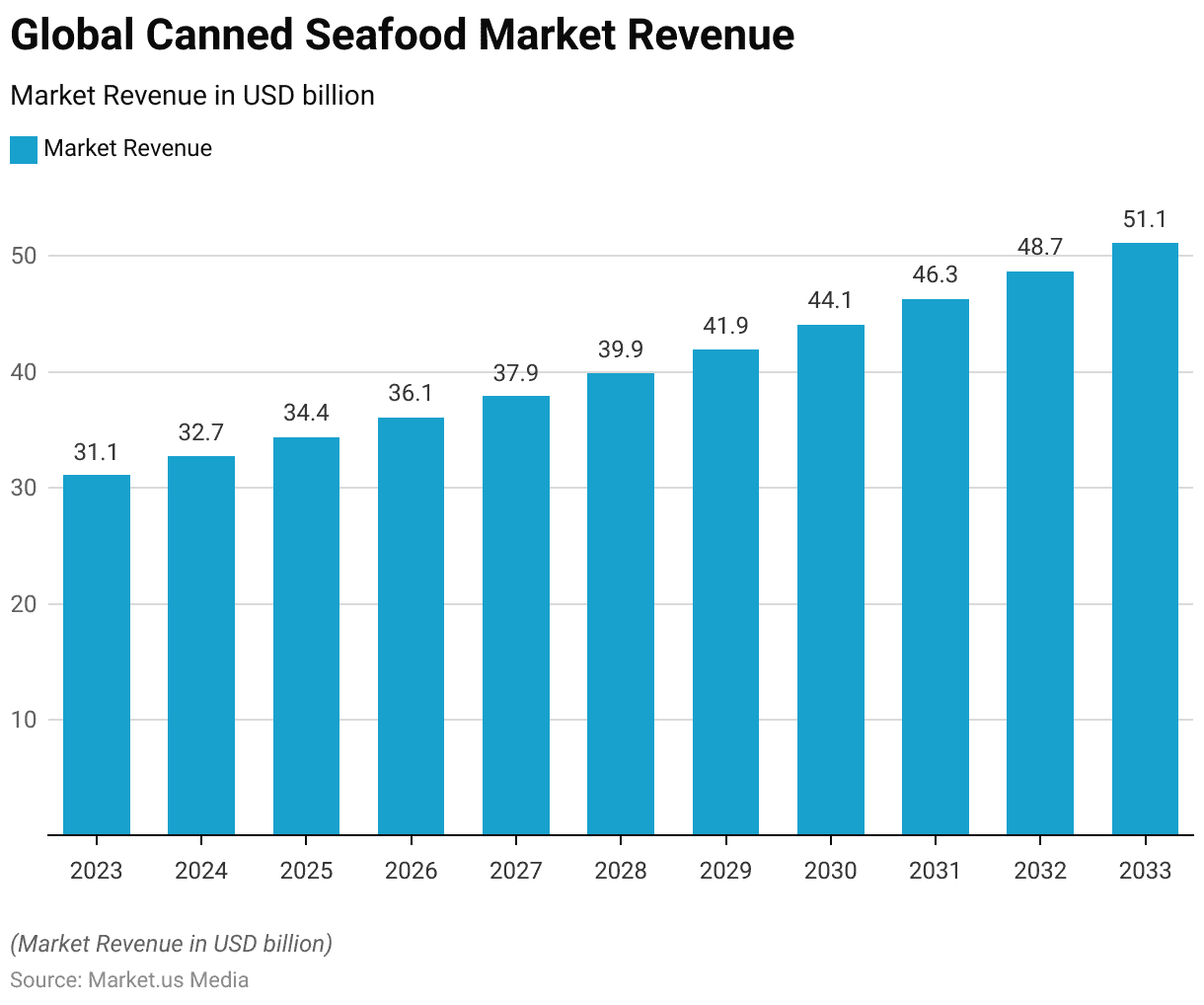
Global Canned Seafood Market Share – By Distribution Channel
- In the global canned seafood market, the distribution channels are predominantly divided between retail and food services.
- Retail channels hold a significant majority share, accounting for 58.30% of the market.
- This dominance indicates a strong consumer preference for purchasing canned seafood through retail outlets, including supermarkets, hypermarkets, and online stores.
- On the other hand, food services channels, which encompass restaurants, cafes, and catering services, constitute 41.70% of the market share.
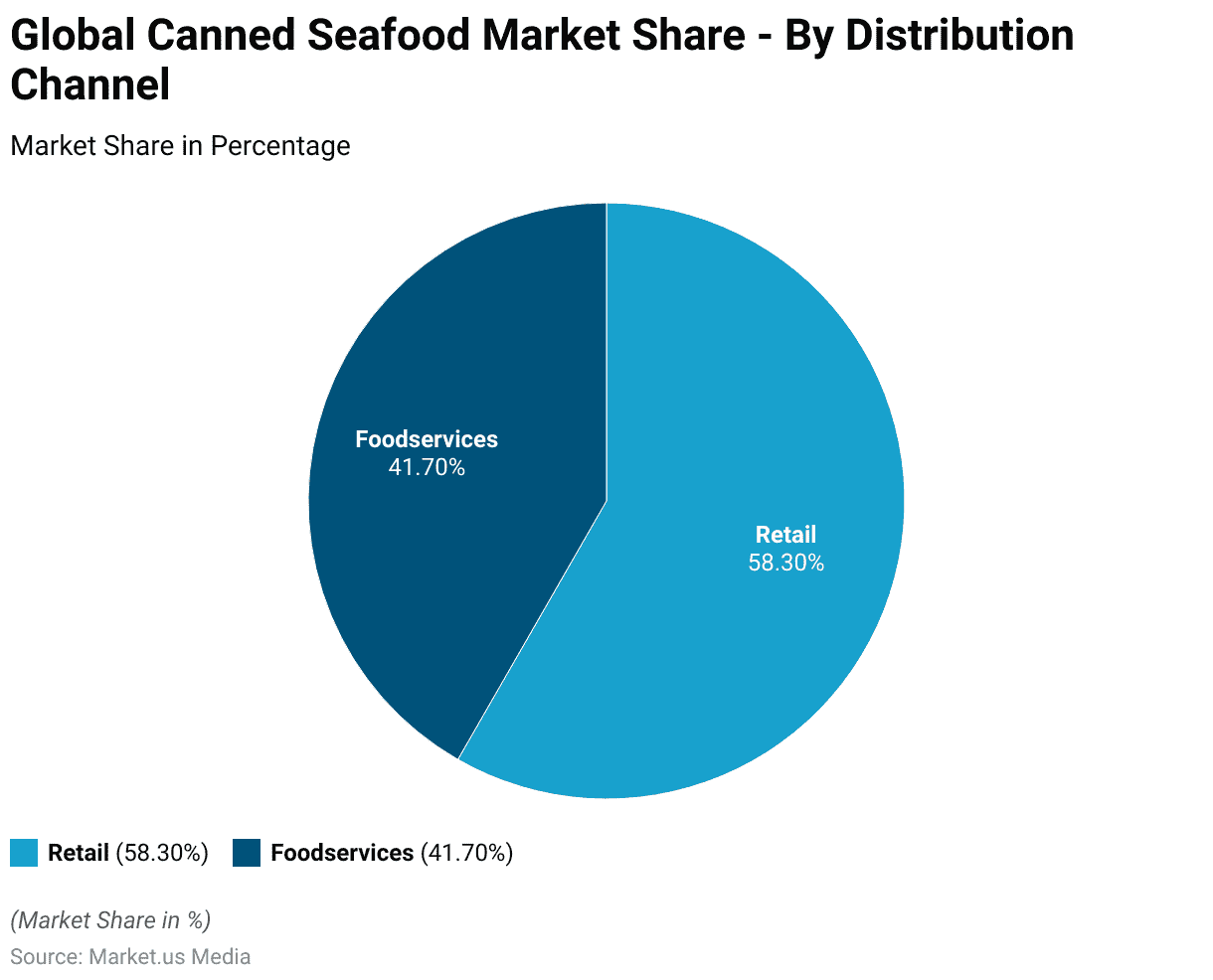
Competitive Landscape of the Global Seafood Market
- The global canned seafood market is characterized by the presence of several key players, each holding varying market shares.
- StarKist Co. leads the market with a 14% share, closely followed by Nippon Suisan Kaisha, Ltd, and Icicle Seafoods Inc., each capturing 12% of the market.
- Maruha Nichiro Corporation holds an 11% share, while LDH (La Doria) Ltd accounts for 10%.
- Wild Planet Foods commands 9% of the market, and Thai Union Frozen Products holds an 8% share.
- American Tuna, Inc. represents 7% of the market.
- Collectively, other key players contribute to the remaining 17% of the market share, highlighting a competitive and diverse industry landscape.
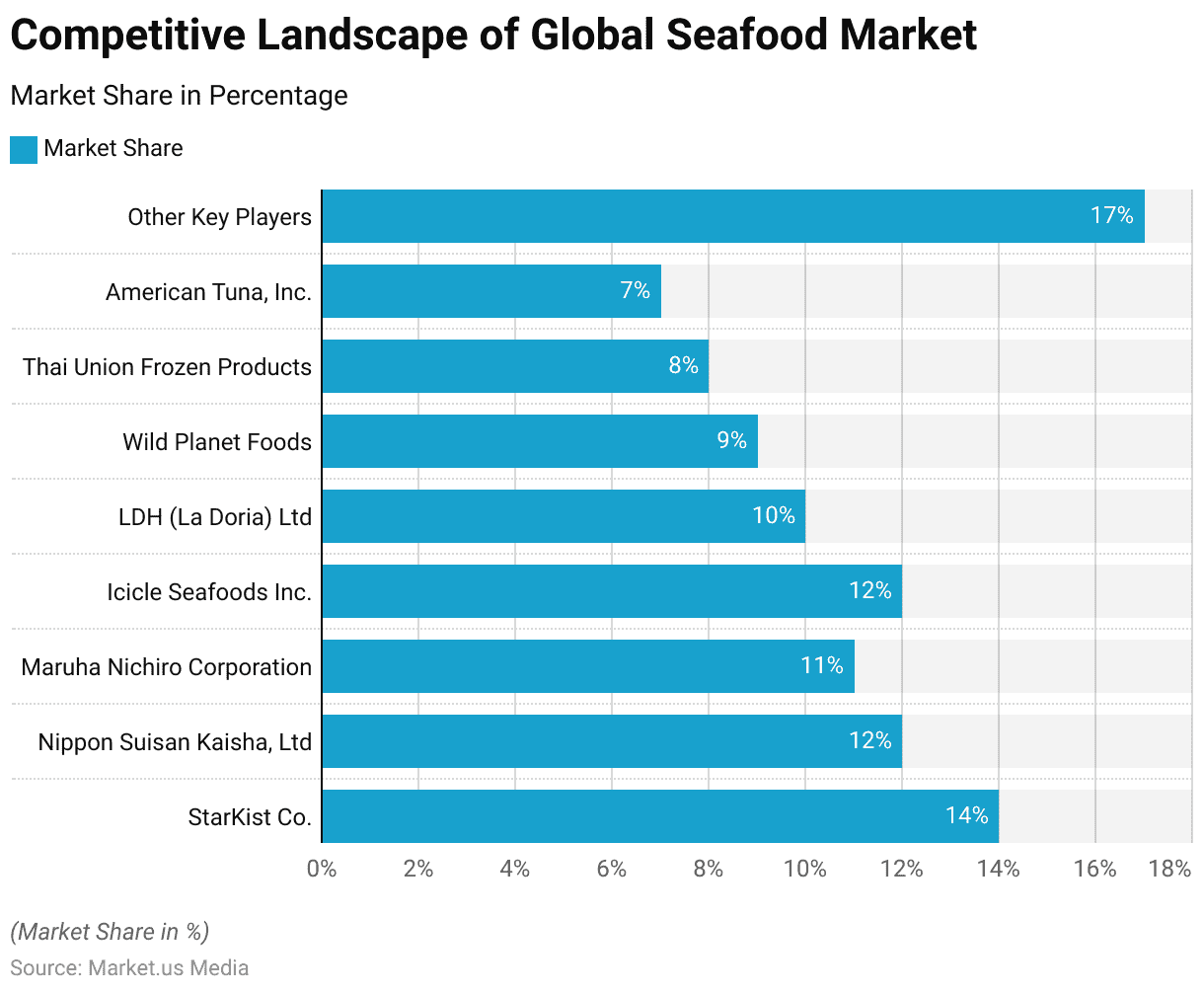
Regional Analysis of the Global Seafood Market
- The global canned seafood market exhibits significant regional variations in market share.
- The Asia-Pacific (APAC) region dominates with a substantial 46.5% share, reflecting the high demand and consumption patterns in countries such as China, Japan, and Southeast Asia.
- North America holds the second-largest market share at 27.0%, driven by strong consumer preferences and a well-established retail infrastructure.
- Europe follows with an 18.0% share, indicating a robust market presence in countries like Spain, Italy, and the United Kingdom.
- South America accounts for 6.0% of the market, while the Middle East and Africa (MEA) region holds the smallest share at 2.5%.
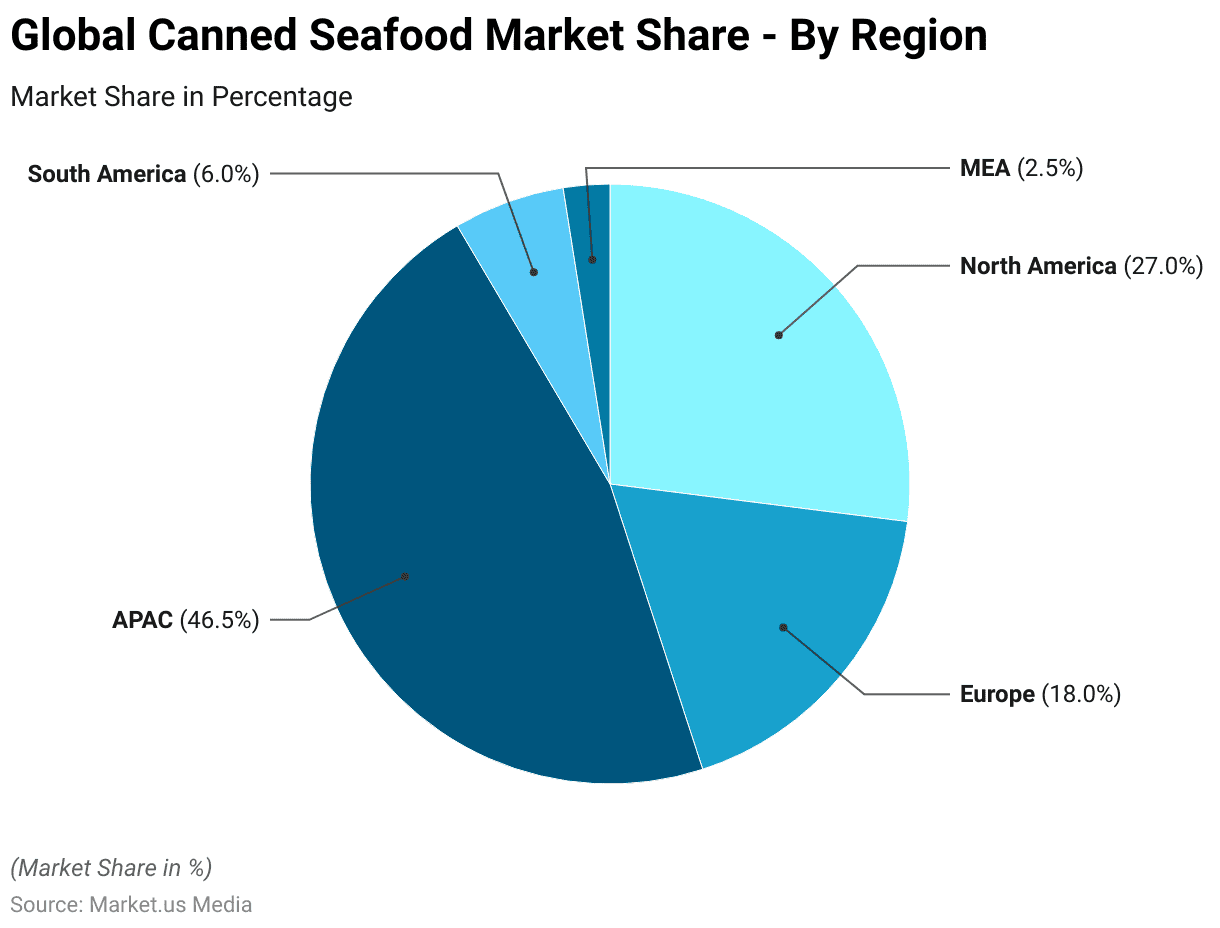
Global Fisheries and Aquaculture Production
- Global fisheries and aquaculture production has experienced notable growth over the past decades, measured in a million tonnes-live weight equivalent.
- In 1990, the production stood at 110.7 million tonnes, increasing to 134.3 million tonnes by 2000.
- This upward trend continued into 2010, with production reaching 162.6 million tonnes.
- By 2018, global production had further escalated to 178.9 million tonnes.
- However, a slight decline was observed in 2019, with production marginally decreasing to 177.4 million tonnes.
- In 2020, the production experienced a slight rebound, increasing to 177.8 million tonnes.
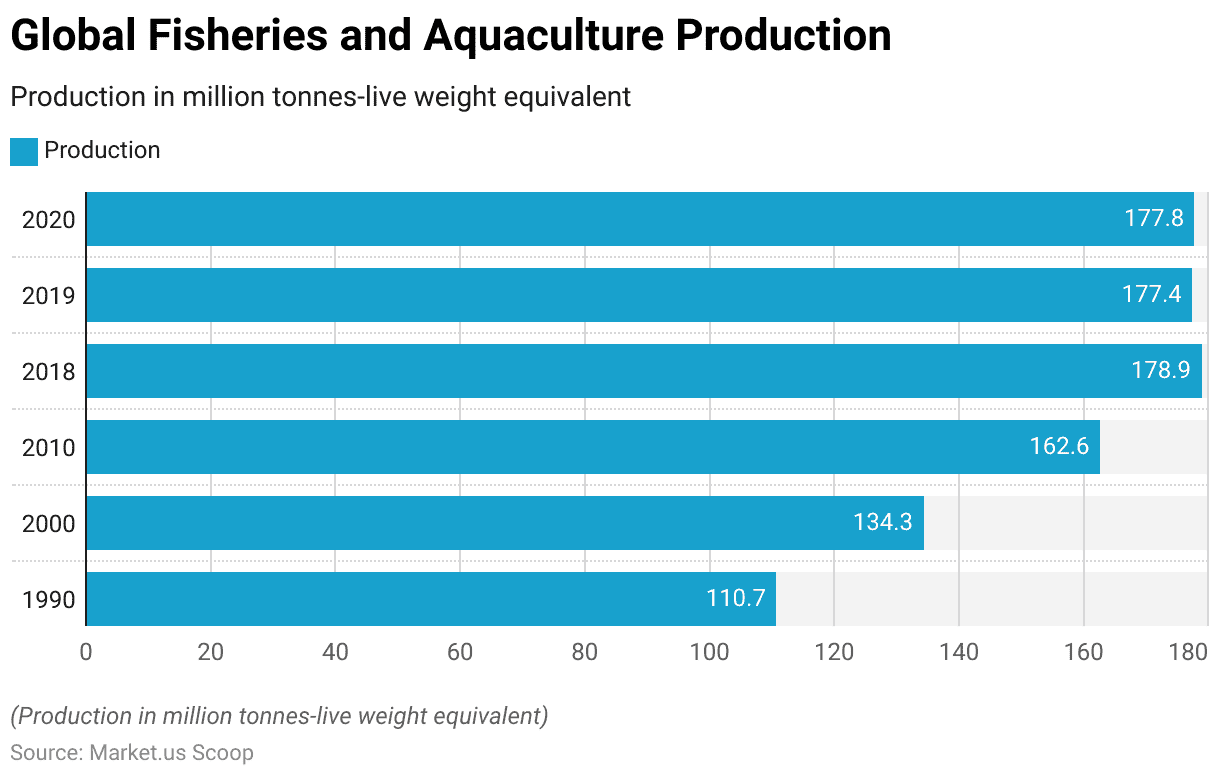
Global Fish and Seafood Consumption Statistics
Fisheries and Aquaculture Products Consumption
- Human consumption of fisheries and aquaculture products has shown a significant increase over the past decades, as measured in million tonnes-live weight equivalent.
- In 1990, the consumption was recorded at 81.6 million tonnes, rising substantially to 109.3 million tonnes by 2000.
- This upward trend continued into 2010, with consumption reaching 143.2 million tonnes.
- By 2018, consumption further increased to 156.8 million tonnes.
- The following year, 2019, saw a slight rise to 158.1 million tonnes.
- However, in 2020, there was a minor decline, with consumption dipping to 157.4 million tonnes.
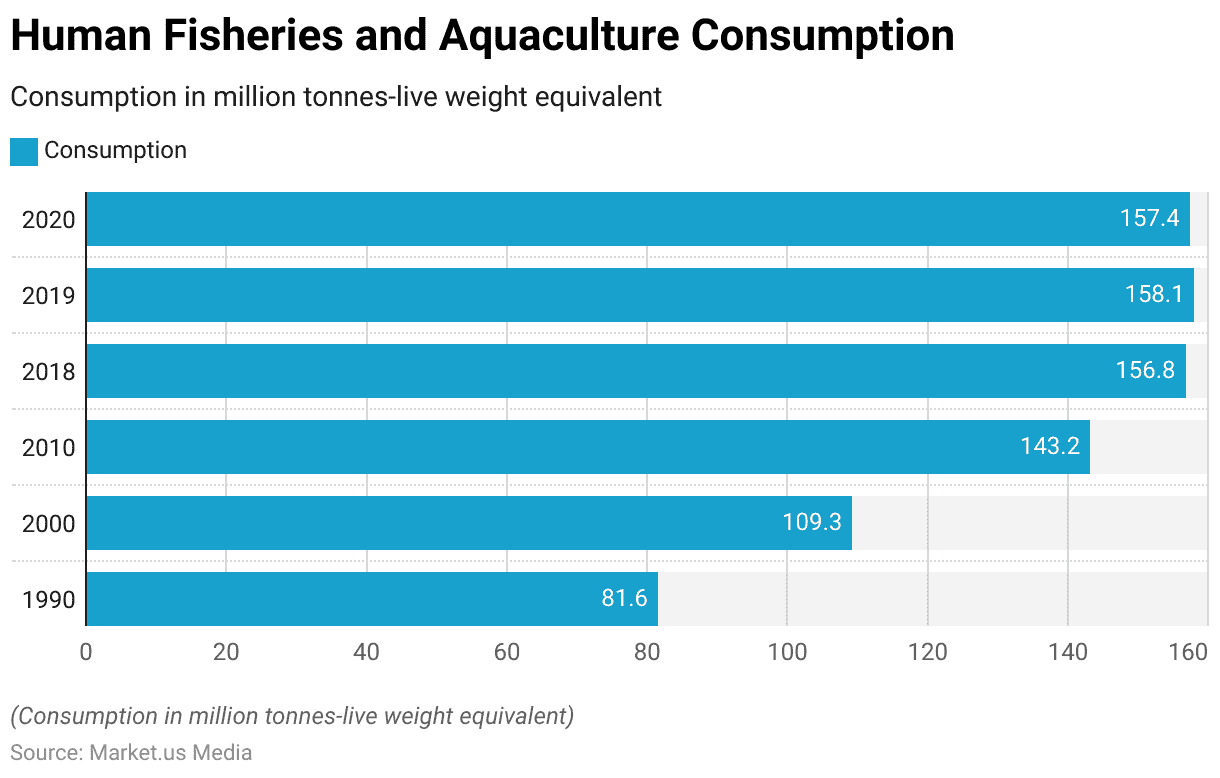
Fish and Seafood Consumption – By Country
- Fish and seafood consumption varies significantly across countries in 2024, with China leading the global market by a substantial margin.
- China consumes 57,475 tonnes of fish and seafood annually, reflecting its high demand and population size.
- Indonesia follows with 12,155 tonnes, while India consumes 11,017 tonnes.
- In the United States, fish and seafood consumption amounts to 7,544 tonnes, and Japan consumes 5,843 tonnes.
- Bangladesh’s consumption stands at 4,399 tonnes, followed by Vietnam with 3,850 tonnes.
- The Philippines consumes 3,185 tonnes, Russia 3,169 tonnes, and South Korea 2,834 tonnes.
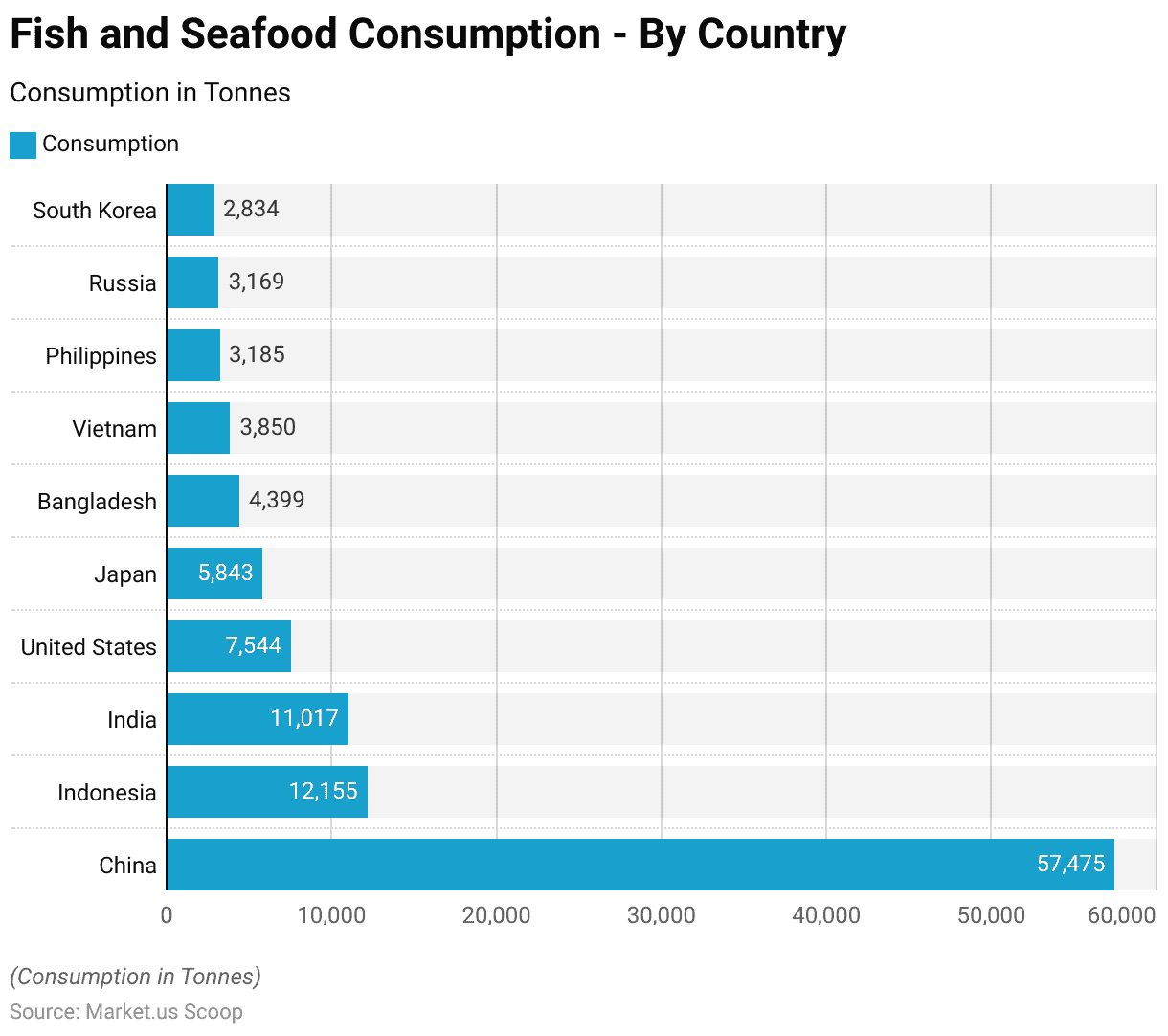
Per Capita Fish and Seafood Consumption – By Country
- In 2019, per capita fish and seafood consumption exhibited significant variation across different countries.
- Iceland led the world with a per capita consumption of 91.19 kg, followed by the Maldives at 84.58 kg.
- Portugal and South Korea showed similar levels of consumption, with 57.19 kg and 57.05 kg, respectively.
- Japan’s per capita consumption stood at 46.06 kg, while Spain’s was 42.4 kg.
- In China, each person consumed an average of 38.49 kg of fish and seafood, with France at 34.24 kg and Italy at 29.82 kg.
- Australia had a per capita consumption of 26.12 kg, and the United States 22.13 kg.
- The United Kingdom and Germany had lower consumption rates, with 18.5 kg and 12.63 kg, respectively.
- Brazil’s per capita consumption was 8.95 kg, while India and Afghanistan had the lowest figures, with 6.76 kg and 0.24 kg, respectively.
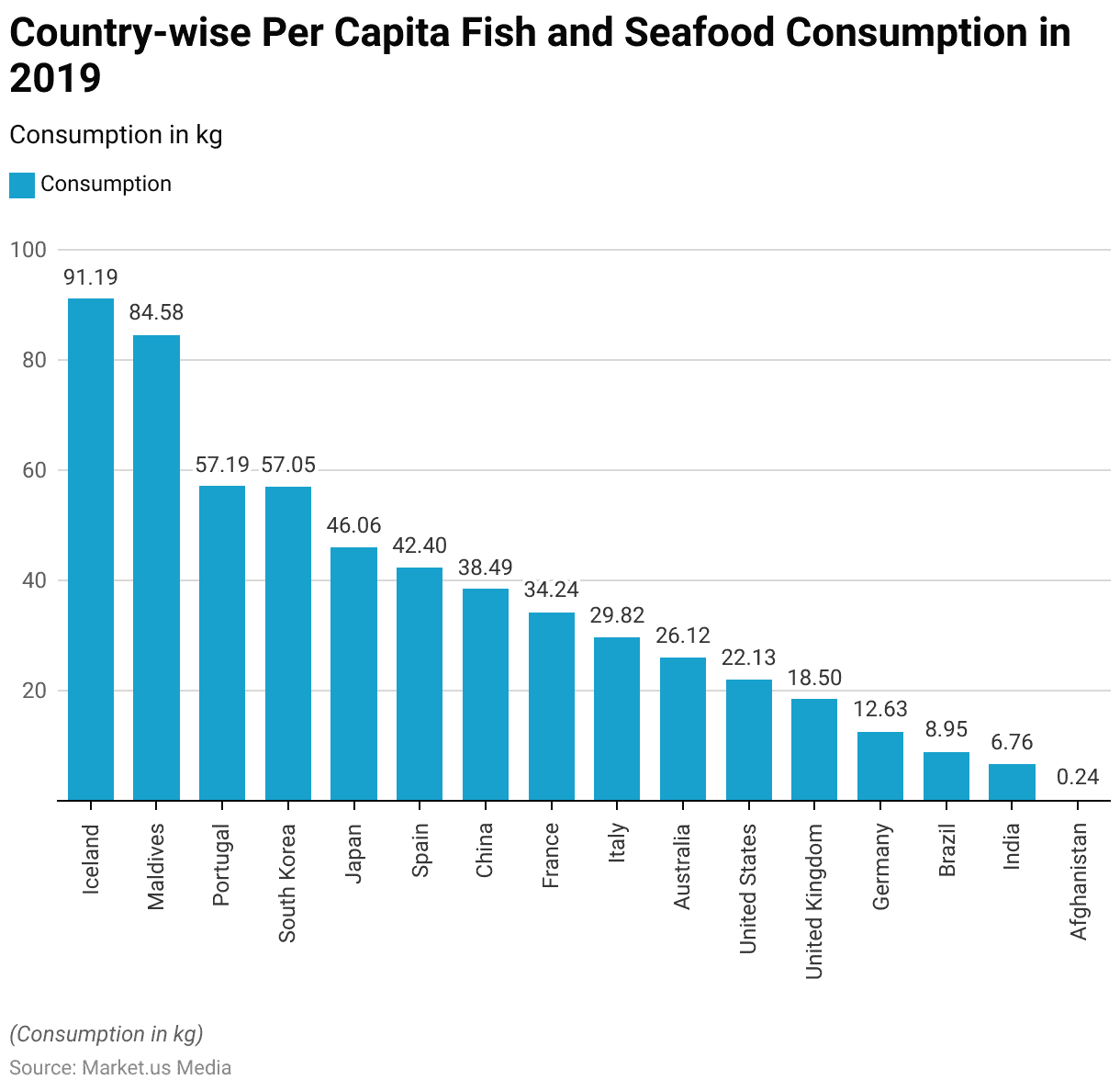
Nutrients Found in Canned Seafood
- Canned seafood is packed with various essential nutrients that offer numerous health benefits.
- For instance, a typical serving of canned sardines provides about 15 grams of protein, 229 milligrams of calcium, and significant amounts of vitamins such as B12, D, and E.
- Additionally, sardines contain 3.61 grams of omega-3 fatty acids, which are crucial for heart health.
- Canned mackerel and tuna also contribute valuable nutrients, with mackerel offering around 19.7 grams of protein and 1.17 grams of omega-3s per serving, while canned tuna is rich in protein (30.47 grams) and low in fat (3.83 grams) per 5-ounce can.
Types of Canned Seafood Products Consumed
- In the United States, about three-quarters of the seafood consumed is either fresh or frozen, and it seems like the amount consumed in these forms has leveled off recently.
- When we break it down, more than half of what consumers are eating in this category is finfish, while the rest is mostly shellfish, especially shrimp.
- Now, when it comes to canned seafood, it makes up just under a quarter of our total seafood consumption, but here’s the kicker: its popularity has been on a downward trend for the past twenty years.
- Canned tuna used to be the king of the canned sea, representing a whopping 60% of all canned seafood consumption.
- But get this—its popularity has taken a nosedive since its peak in 1989 when folks were chowing down on 3.9 pounds per person. Nowadays, it’s a big fat zero.
- Canned shellfish comes in second, making up over 13% of the canned seafood scene, followed by sardines at 6.5%.
Reasons to Consumer Canned Seafood
It’s a Great Source of Omega-3s
- Omega-3 fatty acids are crucial fats that your body cannot produce on its own and must be obtained from food or supplements.
- Research, including a 2019 study in International Immunology, suggests that a diet rich in omega-3s can have widespread benefits, as these healthy fats possess anti-inflammatory properties.
- They are known to improve HDL cholesterol, which aids in protecting against heart disease, as highlighted in a 2018 article in Food & Function.
- Additionally, omega-3 fatty acids contribute to joint health by alleviating inflammation, benefiting individuals with osteoarthritis, according to a 2022 review in Nutrients.
It Lasts Longer Than Fresh or Frozen
- According to a 2018 report by the Food and Agriculture Organization of the United Nations, approximately 27% of all captured fish worldwide is discarded, mainly due to its limited freshness window.
- Canned seafood, being a cost-effective alternative to fresh fish, is preserved in airtight containers through heating or salt, extending its shelf life to years.
It’s a Great Source of Vitamin D & Calcium
- Vitamin D and calcium collaborate to promote bone health. While sunlight aids your body in producing vitamin D, it’s challenging to obtain enough of this nutrient through diet alone.
- Yet, canned fish like tuna, salmon, trout, and sardines are rich sources of both calcium and vitamin D.
- For instance, according to the National Institutes of Health, 3 ounces of salmon provide around 570 IU of vitamin D, equivalent to 71% of the recommended Daily Value.
Consumer Preferences and Trends for Canned Seafood
Relative Importance of Each Canned Seafood Attribute
- In assessing the relative importance of various attributes of canned tuna, consumer preferences reveal a balanced prioritization among several factors.
- Packaging form emerges as the most significant attribute, with 25.49% of respondents indicating its importance.
- Close behind is the eco-label, preferred by 24.79% of consumers, reflecting growing environmental consciousness.
- Flavor is also a key consideration, valued by 24.98% of respondents, emphasizing the importance of taste in purchasing decisions.
- Price, while slightly less critical, still holds substantial weight, with 24.21% of respondents prioritizing cost.

Frequency of Choice of Canned Fish
- A recent survey on the frequency of canned fish consumption last month reveals diverse consumer habits.
- Notably, 31.85% of respondents reported not consuming canned fish at all.
- Among those who did, 13.01% consumed canned fish 1-2 times, and a significant 35.02% enjoyed it 3-4 times, indicating a moderate level of regular consumption.
- Additionally, 14.81% of respondents consumed canned fish 5-8 times, while 3.77% reported consuming it 9-12 times.
- A small yet notable 1.54% of respondents consumed canned fish 13 or more times in the past month.

Regulations for Canned Seafood
- Regulations for canned seafood vary by country, ensuring safety and quality standards are met globally.
- In the United States, the Food and Drug Administration (FDA) enforces stringent regulations under the Hazard Analysis and Critical Control Points (HACCP) system. This system mandates thorough analysis at each stage of production to identify and control potential hazards.
- In the European Union, canned seafood imports must comply with the EU’s sanitary and phytosanitary regulations, which include rigorous standards for additives, contaminants, and labeling.
- The Australian Government Department of Agriculture, Water and the Environment enforces these regulations to maintain high food safety standards.
Discuss your needs with our analyst
Please share your requirements with more details so our analyst can check if they can solve your problem(s)



